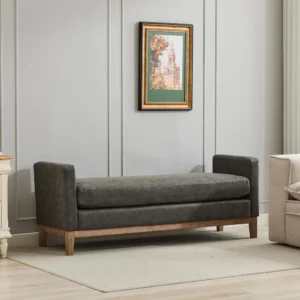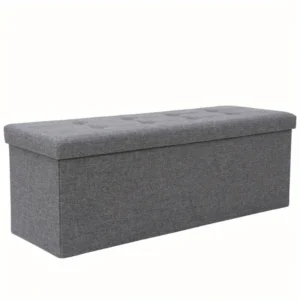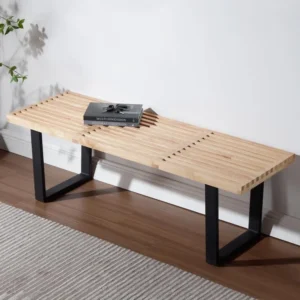The Ideal Height Range for Entryway Benches
When creating a functional and comfortable entryway, bench height plays a crucial role that’s often overlooked. The ideal height for an entryway bench typically ranges from 18 to 20 inches (45-50 cm). This standard measurement isn’t arbitrary—it’s carefully designed to provide maximum comfort while maintaining functionality in your home’s entrance area.
This height range works well for several important reasons:
- It allows most adults to sit comfortably with feet flat on the floor
- It provides adequate knee bend (approximately 90 degrees) for ergonomic sitting
- It balances accessibility for both sitting down and standing up with minimal strain
- It accommodates standard shoe storage underneath while maintaining a clean look
This recommended range represents the sweet spot that furniture designers and ergonomics experts have found works best for the majority of adults. However, as we’ll explore throughout this guide, your perfect bench height might vary based on several personal factors.
Before selecting your bench, understanding how space-saving benches for entryways can transform your home’s entrance will help you make a more informed decision that balances both form and function.
Key Factors That Determine Your Ideal Entryway Bench Height
Finding the perfect entryway bench height isn’t a one-size-fits-all equation. Several key variables need consideration to ensure your bench serves both your functional needs and aesthetic preferences.
The standard 18-20 inch (45-50 cm) recommendation serves as an excellent starting point, but your ideal height will be influenced by:
- The primary users’ height and physical needs
- The bench’s main function (seating, storage, or decorative)
- Your entryway’s dimensions and layout constraints
- Design compatibility with surrounding furniture
- Storage requirements beneath the bench
When considering these factors together, you’ll develop a clearer picture of what will work best in your specific situation. For a deeper understanding of bench dimensions beyond just height, exploring perfect hallway bench dimensions can provide valuable context for your selection process.
Browsing through different entryway bench styles can also help you visualize how various heights might work in your space while meeting your practical needs.
Ergonomics and Comfort: Finding Your Sitting Sweet Spot
Proper ergonomics make the difference between an entryway bench that’s a joy to use and one that becomes uncomfortable after just moments of sitting. When selecting the ideal height, ergonomic considerations should be a top priority.
The most comfortable bench height allows for:
- A 90-degree bend at the knees when seated
- Feet resting flat on the floor without dangling
- Even weight distribution across the thighs
- Minimal pressure on the back of the legs
- Easy transition from sitting to standing position
For most adults, this translates to the 18-20 inch (45-50 cm) range we’ve discussed. However, individuals with longer legs may need a slightly higher bench (21-22 inches or 53-56 cm), while those with shorter stature might prefer something closer to 16-17 inches (40-43 cm).
When sitting to remove boots or shoes after a long day, comfort becomes particularly important. Adding entryway bench cushions can enhance sitting comfort, though remember to account for cushion thickness (typically 1-3 inches or 2.5-7.5 cm) when calculating your ideal bench height.
Functionality Considerations: What Will Your Bench Be Used For?
The intended purpose of your entryway bench significantly impacts the ideal height choice. Different functions require different dimensional considerations to maximize effectiveness.
Primary Seating Function
If your bench will mainly serve as a place to sit while putting on or removing shoes, prioritize the ergonomic height range of 18-20 inches (45-50 cm). This ensures comfortable posture and easy transition between sitting and standing positions.
Shoe Storage Function
For benches with under-seat storage designed for shoes:
– Allow minimum clearance of 6-8 inches (15-20 cm) underneath
– Consider your tallest footwear (typically winter boots at 10-12 inches or 25-30 cm)
– Factor in additional space for easy access and visibility
– Remember that higher bench heights provide more under-bench storage capacity
Multi-Purpose Designs
Many homeowners need their entryway bench to serve multiple functions. In these cases, finding the right balance becomes essential:
- Standard height benches (18-20 inches/45-50 cm) with open bottoms work well for both sitting and storing larger items
- Higher benches (20-22 inches/50-56 cm) provide more storage space but may require a small footrest for comfortable sitting
- Lower benches (16-18 inches/40-45 cm) offer easier access for children but limit underneath storage options
Decorative Benches
When the bench serves primarily as a decorative element, you have more flexibility with height. In these cases, selecting a bench that complements other furniture pieces and fits the overall aesthetic becomes more important than strict ergonomic guidelines.
Properly organizing your entryway bench can maximize functionality regardless of height. Additionally, exploring storage bench options can help you find the perfect balance between sitting comfort and storage capacity.
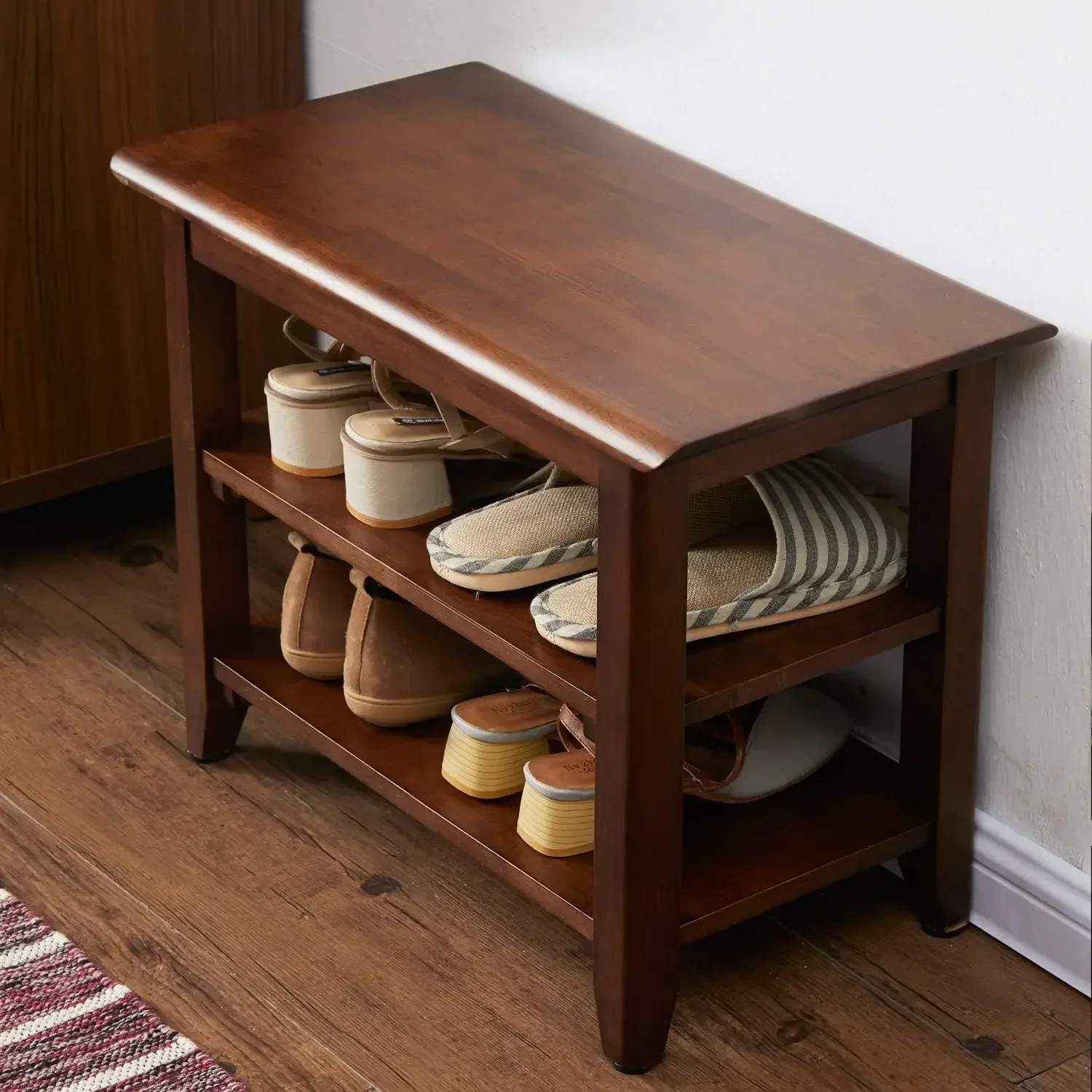
Who Will Use the Bench: Height Adjustments for Different Users
Different household members may have varying physical requirements that affect the ideal bench height. Finding a balance that accommodates everyone requires careful consideration of who will use the bench most frequently.
| User Height | Recommended Bench Height |
|---|---|
| Under 5‘2” (157 cm) | 16-17 inches (40-43 cm) |
| 5‘2” to 5‘9” (157-175 cm) | 18-19 inches (45-48 cm) |
| 5‘10” to 6‘2” (178-188 cm) | 19-20 inches (48-51 cm) |
| Over 6‘2” (188 cm) | 20-22 inches (51-56 cm) |
| Children | 12-16 inches (30-40 cm) |
For households with multiple users of different heights, consider these approaches:
- Select a height that works best for the primary users
- Choose a bench with varying heights (like a stepped design)
- Add cushions or footrests to accommodate different users
- Incorporate multiple seating options in the entryway
If you’re unsure whether an entryway bench is the right solution for your household, exploring whether you need an entryway bench can help clarify if this furniture piece aligns with your family’s daily routines and needs.
Harmonizing With Your Entryway Design: Aesthetic Considerations
While functional aspects are crucial, your entryway bench should also complement your home’s visual style. The height of your bench plays a significant role in creating a harmonious entryway design.
Consider these aesthetic factors when determining bench height:
- Visual balance between the bench and surrounding furniture pieces
- Proportion relative to wall height (lower ceilings often work better with lower benches)
- Alignment with other horizontal elements like wainscoting or chair rails
- Sightlines across the entryway (taller benches can block views and make spaces feel smaller)
- Relationship to nearby console tables, coat racks, or wall hooks
From a design perspective:
– Lower benches (16-18 inches/40-45 cm) create a more open feel and appear less dominant
– Standard height benches (18-20 inches/45-50 cm) provide balanced proportions in most spaces
– Taller benches (20-22 inches/50-56 cm) create more presence and can anchor larger entryways
For smaller entryways, exploring small benches for entryways can help you find options that maintain proper height while fitting compact spaces. If your home features contemporary design, modern entryway benches often emphasize clean lines with carefully calibrated heights that support both function and style.
Space Constraints: Working With What You Have
Your entryway’s specific dimensions will influence the ideal bench height. Adapting to spatial limitations requires thoughtful consideration of how height interacts with available space.
When dealing with space constraints, consider these practical guidelines:
- For narrow entryways, bench heights of 18-19 inches (45-48 cm) typically work best, as taller benches can feel imposing in tight spaces
- When placing benches under windows, ensure the bench height doesn’t obstruct the window sill (typically leaving 2-3 inches/5-8 cm clearance below sill)
- For benches positioned under coat hooks or wall-mounted storage, allow 12-15 inches (30-38 cm) clearance between the bench surface and bottom of hooks
- Corner bench placement may allow for slightly taller options since they occupy less visual space in the room
For comfortable circulation, maintain these minimum clearances around benches:
– 24 inches (61 cm) in front of the bench for sitting and standing
– 30 inches (76 cm) for walkways beside or in front of the bench
– 36 inches (91 cm) for high-traffic pathways through the entryway
Solutions like space-saving entry benches can help maximize function without overwhelming smaller entryways. For particularly challenging spaces, narrow entryway benches provide specialized proportions that maintain proper sitting height while minimizing footprint.
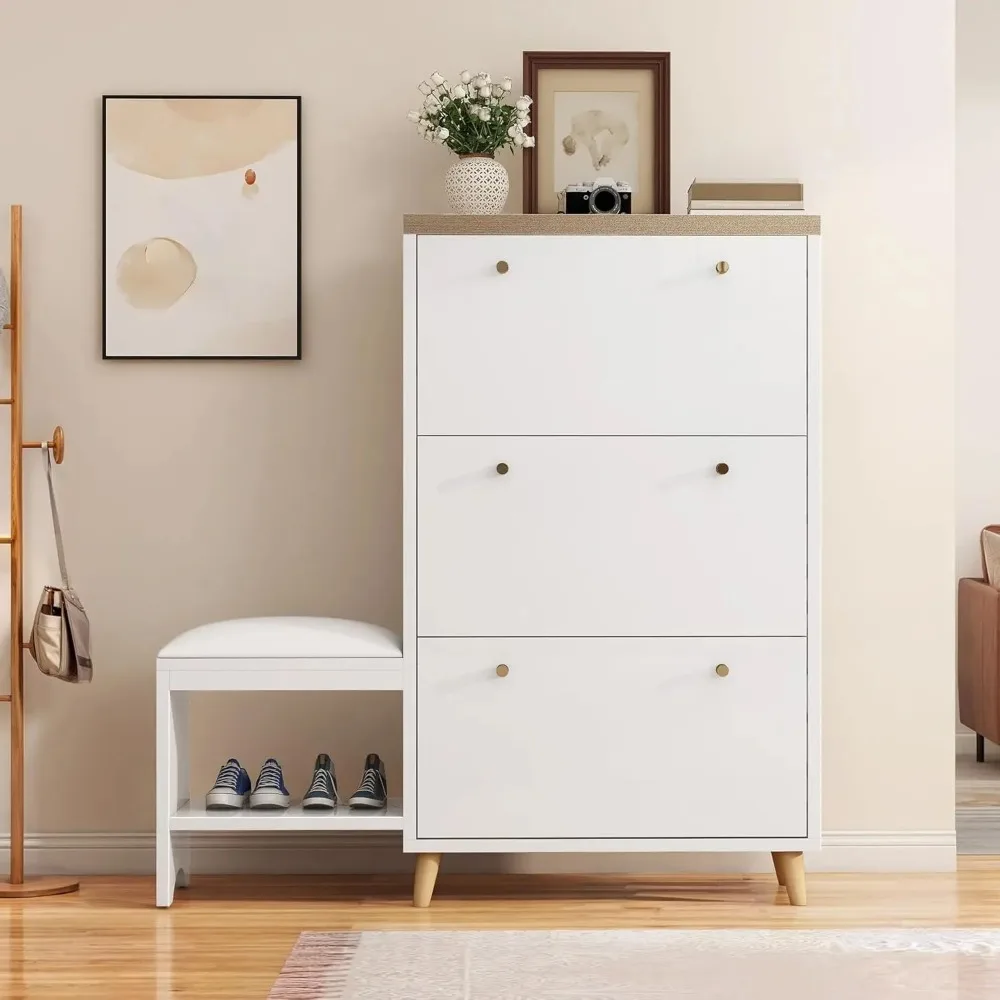
How to Measure and Test for Your Perfect Bench Height
Before purchasing an entryway bench, taking the time to measure and test potential heights can save you from making an uncomfortable or impractical choice. Use these simple methods to determine your ideal bench height.
Step-by-Step Measurement Process:
- Measure your existing seating: Find a comfortable chair or bench in your home and measure from the floor to the top of the seat surface
- Test with makeshift seating: Stack books or boxes to different heights and test sitting on them (with a cushion for comfort)
- Check knee angle: When seated, your knees should form approximately a 90-degree angle with feet flat on the floor
- Simulate daily use: Practice the motions of removing shoes and standing up to ensure comfort
Important Measurement Tips:
- Measure while wearing typical footwear you’d have on when using the bench
- Account for seasonal variations (winter boots may require different ergonomics)
- If adding cushions, subtract their compressed thickness (usually 1-2 inches/2.5-5 cm when sat upon) from your ideal height
- Test with all primary users of different heights when possible
For a more comprehensive approach to bench selection beyond height, exploring our complete guide to choosing a compact bench provides additional insights into finding the perfect fit for your space and needs.
Beyond Height: Complete Bench Dimensions for a Perfect Fit
While height is crucial, a well-designed entryway bench requires carefully balanced proportions across all dimensions. Understanding the relationship between height, width, and depth ensures a bench that looks appropriate and functions effectively.
Standard Entryway Bench Dimensions
| Dimension | Recommended Range | Ideal for Most Homes |
|---|---|---|
| Height | 16-22 inches (40-56 cm) | 18-20 inches (45-50 cm) |
| Depth | 14-20 inches (35-50 cm) | 15-17 inches (38-43 cm) |
| Width | 36-60 inches (91-152 cm) | 42-48 inches (107-122 cm) |
| Under-bench clearance | 6-12 inches (15-30 cm) | 8-10 inches (20-25 cm) |
Height-to-Depth Relationship
The depth of your bench directly affects comfort at different heights:
– Lower benches (16-18 inches/40-45 cm) typically need greater depth (17-20 inches/43-50 cm) for proper thigh support
– Standard height benches (18-20 inches/45-50 cm) work well with medium depths (15-17 inches/38-43 cm)
– Taller benches (20-22 inches/50-56 cm) can function with shallower depths (14-16 inches/35-40 cm)
Width Considerations
Width should be determined by:
– Number of people likely to sit simultaneously (allow 24 inches/61 cm per person)
– Available wall space in your entryway
– Visual proportion relative to the entryway size
For homes with limited space, small entryway benches offer carefully calibrated dimensions that maximize functionality while minimizing footprint.
Entryway Bench with Cushion, Mudroom Bench with Cushion, Shoe Bench for Entryway
$1,186.63 Select options This product has multiple variants. The options may be chosen on the product pageCoat Rack Shoe Bench, Corner Entryway Bench, Corner Hall Tree, Shoe Bench for Entryway
$313.58 Select options This product has multiple variants. The options may be chosen on the product pageEntryway Bench with Back, Modern Entryway Bench, Shoe Bench for Entryway
Price range: $463.13 through $474.44 Select options This product has multiple variants. The options may be chosen on the product pageEntryway Bench with Shelf Storage, Shoe Bench for Entryway, Shoe Storage Bench
$194.08 Select options This product has multiple variants. The options may be chosen on the product pageCorner Entryway Bench, Entryway Bench with Cushion, Modern Entryway Bench, Shoe Bench for Entryway
$476.34 Select options This product has multiple variants. The options may be chosen on the product pageModern Entryway Bench, Wood Entryway Bench, Wood Mudroom Bench
$497.69 Select options This product has multiple variants. The options may be chosen on the product page
Special Cases: Unique Entryway Bench Solutions
While standard guidelines work for most situations, certain scenarios require specialized approaches to bench height. These unique solutions can address specific challenges in your entryway.
Built-in Benches
Custom built-in benches offer the advantage of precise height tailoring to your household’s needs. When designing built-ins:
– Consider making them slightly lower (17-18 inches/43-46 cm) than freestanding benches, as they typically don’t compress under weight
– Ensure the seat depth compensates appropriately for the custom height
– Account for any planned cushions in your height calculations
Benches with Backrests
When incorporating a backrest, the seat height often requires adjustment:
– A slight reduction in height (17-19 inches/43-48 cm) can improve comfort with a backrest
– The angle of the backrest affects the optimal seat height (more reclined backs work better with lower seats)
– Ensure proportional relationship between seat height and backrest height (backrest typically 15-18 inches/38-46 cm above seat)
Adjustable-Height Options
For maximum versatility, especially in multi-user households:
– Consider benches with adjustable legs or modular designs
– Look for height ranges of approximately 16-22 inches (40-56 cm)
– Ensure stability at all height settings
Storage-Focused Solutions
When shoe and equipment storage is the primary concern:
– Higher benches (20-22 inches/50-56 cm) provide more under-bench clearance
– Hinged-top storage benches typically work best at standard heights (18-20 inches/45-50 cm)
– Multi-level designs can offer varied heights for different users and functions
Specialized options like benches with backrests provide additional support that may influence your ideal height requirements.
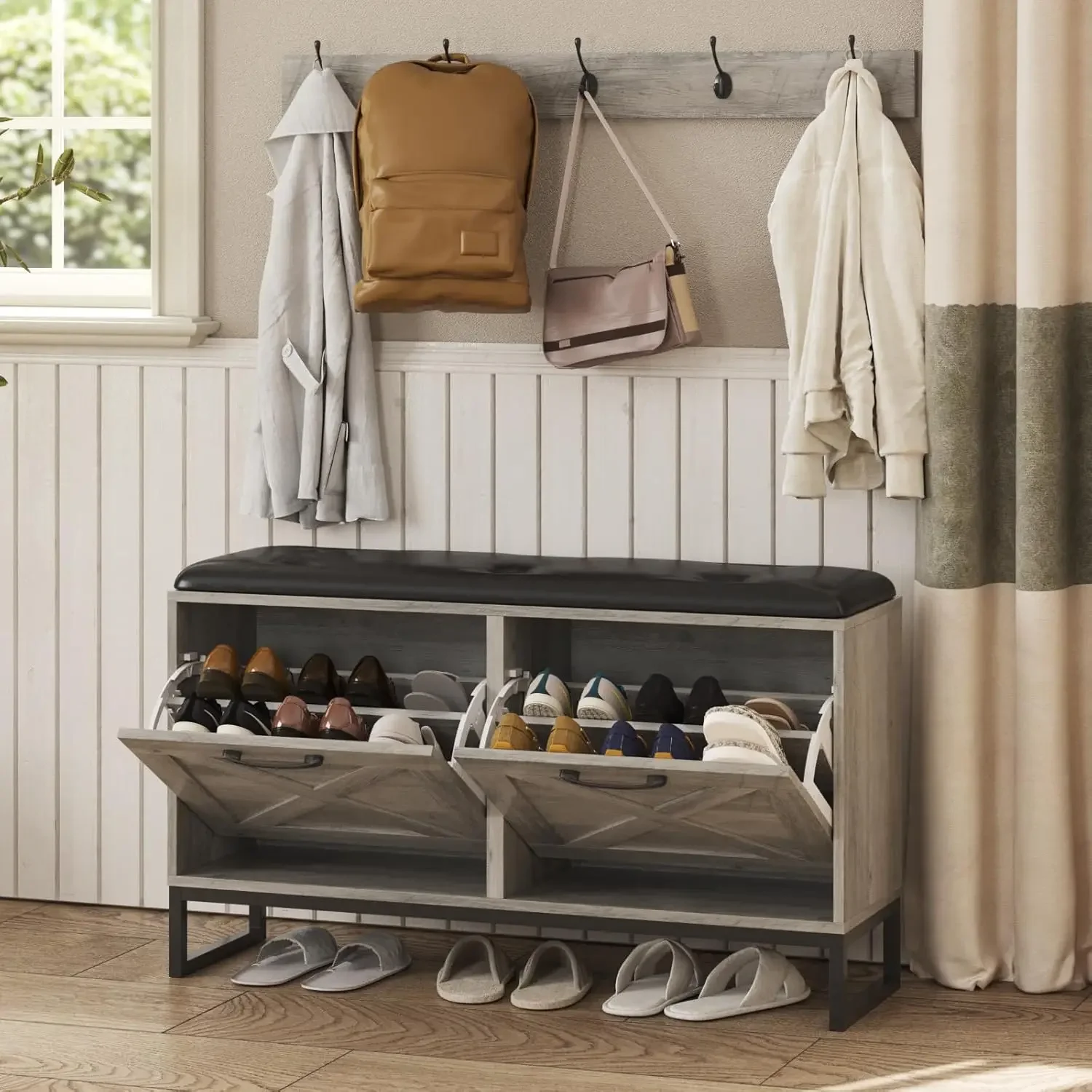
Common Height Mistakes to Avoid When Choosing Your Entryway Bench
Even with careful planning, certain height-related pitfalls commonly trip up homeowners when selecting an entryway bench. Being aware of these mistakes can help you avoid discomfort and functionality issues.
Bench Too High (Above 22 inches/56 cm)
When a bench sits too high, it creates several problems:
– Feet dangle uncomfortably without touching the floor
– Pressure increases on the back of thighs, restricting circulation
– Getting up and sitting down becomes more difficult
– The bench appears disproportionate to surrounding furniture
Bench Too Low (Below 16 inches/40 cm for Adults)
Excessively low benches cause:
– Difficulty standing up, particularly for older adults or those with mobility issues
– Uncomfortable knee angles beyond 90 degrees
– Poor posture when sitting
– Reduced functionality for everyday shoe changes
Overlooking Under-Bench Clearance
A common oversight is failing to consider what will be stored underneath:
– Winter boots need at least 8-10 inches (20-25 cm) of clearance
– Storage bins typically require 10-12 inches (25-30 cm)
– Insufficient height makes accessing stored items frustrating
Ignoring User-Specific Requirements
One-size-fits-all thinking often leads to:
– Discomfort for household members who differ significantly from average height
– Accessibility issues for elderly family members or those with physical limitations
– Challenges for children using the bench independently
For households where shoe storage is a primary concern, shoe storage benches offer specialized height configurations that balance sitting comfort with practical storage capacity.
Finding Your Perfect Bench Height: Final Recommendations
After exploring all the factors that influence entryway bench height, we return to the fundamental recommendation of 18-20 inches (45-50 cm) as the optimal starting point for most homes. This range successfully balances ergonomics, functionality, and design for the majority of users and spaces.
Remember these key takeaways when making your final decision:
- Prioritize user comfort by ensuring proper knee angles and foot placement
- Consider all functions your bench will serve, from seating to storage
- Account for your specific entryway dimensions and existing décor
- Test before purchasing whenever possible
- Make adjustments based on your household’s unique needs
Your ideal bench height might vary slightly from standard recommendations, and that’s perfectly fine. The best entryway bench is one that serves your specific needs while creating a welcoming entrance to your home.
When selecting your perfect entryway bench, balance these practical considerations with aesthetic preferences to create an entrance that’s both beautiful and functional. The right bench at the proper height becomes more than just furniture—it’s a daily-use feature that enhances your home’s organization and welcome appeal.
At Nested Goods, we understand that thoughtfully designed entryway furniture transforms not just your space, but your daily home experience. The perfect bench height is just one aspect of creating an entryway that truly works for your lifestyle.


